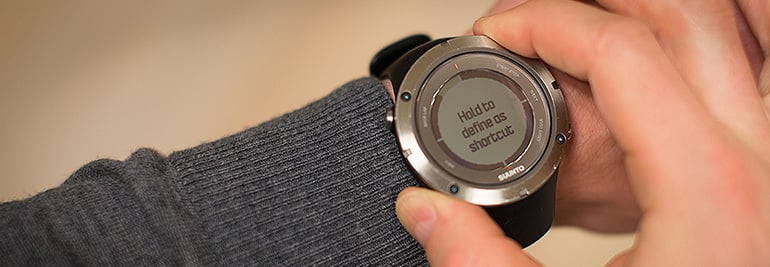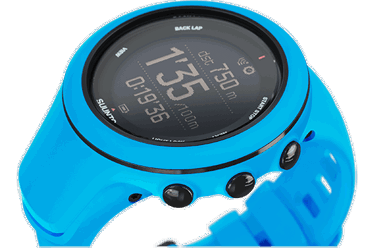

Suunto Blog

Running across the USA with Patrick Sweeney
Patrick Sweeney may have pulled out of Race Across USA but he's continuing anyway in a bid to cross the States from California to Washington D.C. by foot.
Since setting out mid-January in a running race across the USA, the Suunto-supported athlete has so far clocked 2,000 km of the 5,000 km journey. Unfortunately he had to pull out of the race itself, but is continuing the journey anyway with New Zealand runner Jup Brown as a fundraiser for various charitable projects.
Patrick Sweeney is a barefoot devotee, whatever the weather. ©Patrick Sweeney
Says Patrick: “Since Jup and I started Run With Us America we have been professional speakers at a health expo, interviewed by four radio stations, featured in three newspapers, spoken to hundreds of children at multiple schools, been joined by runners from five countries and at least seven different breeds of dog and received thousands of waves from passers-by. Most importantly we have had a lot of fun and inspired a few people along the way.”
Continuing along the same route as Race Across USA, the pair’s main goal is to raise money for the 100 Mile Club, a non-profit that encourages children to run 100 miles a year, with the aim of improving fitness, learning and self-esteem.
So far the team have crossed the states of California, New Mexico and Arizona. They are currently in central Texas, nearly halfway to the US capital. Watch a video of their New Mexico leg below.
“We have been able to run 30-35 miles (48-56 km) each day. My Ambit3 is working great and keeps me motivated,” he adds.
Main image: ©Patrick Sweeney

Get running, says Ryan Sandes
Now's the perfect time to be out there running, says Suunto ambassador Ryan Sandes, well – at least it is in the southern hemisphere. The Cape Town based runner is making the most of mid-summer weather to gear up for a couple of big projects for 2015, as he tells us below. What's in your sights: I'm very excited by the challenge of new races. I'm looking forward to TransVulcania in May. The distance of 83km will suit me. What else?The Western States. I've done it twice so I'm going there with high expectations! I've never run the UTMB and hope to run that in 2016. Another key 100 miler on my list is the Raid Reunion.
Ryan during the Grand Drakensberg Traverse FKT ©Kelvin Trautman / Red Bull Content Pool Racing or FKT, what makes your heart beat? I enjoy racing but what drives me is the FKT movement. [Fastest Known Times: the challenge of setting a record time on a set route, typically up or across mountains, organised independently.]I enjoy the whole adventure of setting yourself a challenge, the whole behind the scenes thing, checking maps, preparing, not knowing what lies ahead, it beats my soul. That really excites and motivates me. In a race you know you will finish. With an FKT you don't actually know if you will and that's really exciting. There are a few FKTs I'm looking at. Most are in Africa around Kenya and Tanzania.
Ryan pictured at home in South Africa ©Kolesky/Nikon/Red Bull Content Pool Tell us about the Grand Drakensberg Traverse. [In March 2014 Ryan Sandes and Ryno Griesel smashed the FKT for the 204km traverse of the Drakensberg mountains in South Africa, running the wild mountain ridgeline in 41h and 49m.]It was really cool to achieve but it wasn't just about running the fastest time. It was the whole experience of crossing the mountains north to south.What was the hardest part? The preparation when we scouted the route! We had really bad weather – I've never seen anything like it. There was snow, hail, lightning and torrential rain. It was pretty scary! The next time I got hammered by the altitude. Every time an element humbled me. Peak or Sport?I'm using the Ambit3 Sport Blue and really enjoying that. The Suunto Movies are really cool. But for my longer runs I'm more of a Peak guy for the longer battery. It's really useful to be able to track my distance and climbs.
Ryan running the Fish River canyon in 2012 ©Kolesky/Nikon/Red Bull Content PoolWhat's next? I'm setting up an FKT that other people can try but can't say any more at the moment! Suunto ambassador Ryan Sandes, 32, won the 4 Desert series in 2010 and won the Leadville 100 in 2011.

Coast to Coast: an iconic adventure race
Speight’s Coast to Coast is an iconic multisport race across New Zealand's South Island. Every year, more than 800 competitors line up to run, cycle and paddle the 243km width of the island. No one knows more about the event than 5-time winner and current race director, Richard Ussher. He explains its enduring appeal.
Why is the race so iconic?What really sets it apart is the concept of crossing a country in a day (or two). New Zealand’s South Island is the perfect distance – long enough to be a real challenge, yet short enough to be achievable by more than just the truly insane.
Is it more adventure-race or triathlon?I’d say it falls between the two. Top competitors certainly treat it more like a triathlon, where further down the field you probably get more into the adventure-racing realm.
Richard also created a Suunto Movie of the Coast to Coast Mountain Run course with his Suunto Ambit3, which you can see here.
Post by Richard Ussher.
Which discipline decides who wins?You really have to be an all-rounder to win. The two sections that tend to decide the race are the Mountain Run and the Kayak. But then there’s still 70km of cycling to finish it off – normally into a stiff headwind.
Did you record the Running Stage time yourself?Yes. It’s probably close to what the bulk of the better two-day runners will set. The top one-day and team competitors are closer to the 3-hour mark though. Last year’s winner Braden Currie clocked 2:49 for the run.
How did you become race director?The event was sold to a company called Trojan Holdings in 2013. They contacted many former participants and asked them where they thought the race needed to go. I was a little vocal in my opinions, and after talking with them, ended up in the role. It certainly wasn’t something I thought about before, but it’s a great opportunity.
So you’re retired?No, I’m not retired. I had a very tough 2014 because of injury, but I can finally see light at the end of that tunnel. My focus is obviously on the management side of Coast to Coast now, but I still love getting out and competing. Nowadays, I’m more focused on competing in races that I’ve always wanted to do.
How do you like the Suunto Movie Tell us about Suunto Movie on the Ambit?I really like this feature, especially where you get to see the whole course in the revolving view. I can see it being really useful for multisport athletes, as it gives you an idea of what the course might be like, and to a certain degree helps create a picture of the gradients involved.
Have you used Suunto products before?Yes, I’ve been using Suunto products from early on in my adventure-racing career – starting with the Suunto Advizor, which I still have. I also use the global compass range and orienteering compasses as well as Suunto’s Ambit and Core watches. Suunto products have always been fantastic.
Follow the race here: www.coasttocoast.co.nz
All pics ©sportzhub.com

Tutorial Tuesday: Customize your Ambit’s shortcut button
Do you have a favorite Ambit feature that you wish you could access quicker? No worries, in time mode you can access any menu item with a single push of a button after you have taught your Ambit2 or Ambit3 what you wish the shortcut button will do.
The shortcut button comes in handy in many ways. For example, it is a quick way to set the wake-up alarm and travellers can use the shortcut to easily set the dual time to match the destination’s time zone. And for your most frequent activity the shortcut button can lead straight to the right sport mode setting you ready to go with a single push of a button.
Here's how to use your Ambit's shortcut.
DEFINE A SHORTCUT
By default, when you keep [View] pressed in TIME mode, you toggle the display between light and dark. This shortcut can be changed to a different menu item.
To define a shortcut:
1. Keep [Next] pressed to enter the options menu or press [Start Stop] to enter the start menu.2. Browse to the menu item to which you want to create a shortcut. 3. Keep [View] pressed to create the shortcut.
Your own shortcut works when the watch is in time mode. In other modes, keeping [View] pressed accesses predefined shortcuts. For example, when the compass is active, you can access the compass settings by keeping [View] pressed.
NOTE: Shortcuts cannot be created to all possible menu items, such as individual logs.
You can get support for your Suunto product at support

Suunto Guiding Stars are on a journey
A few weeks ago the first three Suunto Guiding Stars were sent on a journey, passing from one adventure-minded woman to the next.
Suunto ambassador Emelie Forsberg, Scuba Diver Girl Margo Sanchez and cross country skier Aino-Kaisa Saarinen all kept one of the Guiding Star pendants for a while and passed them on to a person they admire for her attitude, her achievements, her adventurous mindset and her energy.
Emelie was the first one to pass on her Guiding Star. She gave it to Norwegian musher Sigrid Ekran.
Time to pass this #SuuntoJewel along to another star! Sigrid Ekran it will arrive soon!
A photo posted by Emelie Forsberg (@tinaemelie) on Jan 15, 2015 at 11:17pm PST
Thank you Emelie Forsberg for this beautiful jewelry #suuntojewel It will follow me and my dogs for a while, then I will pas it on to the next adventurous women. Proud to be part of this! #suunto #emelieforsberg #adventurouswomen
A photo posted by Sigrid Ekran (@teamsigridekran) on Jan 25, 2015 at 7:34am PST
Margo soon followed. She gave her Guiding Star to Becky Kagan Schott, an Emmy Award winning underwater videographer, photographer and tech instructor.
Passing this #SuuntoJewel along to @beckykagan ... a strong, beautiful, adventurous woman!!! #scubadivergirls #SuuntoDive #SuuntoGuidingStar
A photo posted by Scuba Diver Girls (@scubadivergirls) on Jan 27, 2015 at 12:15pm PST
Also Aino-Kaisa's silver compass pendant has started travelling. It is now in the hands of American skier Liz Stephen: http://bit.ly/1F79LQ5
Follow the journey of these functional pieces of jewelry with #SuuntoJewel
Learn more about Suunto Guiding Star

Suunto Ambit3 Sport wins the Good Design Award
Suunto is proud to announce winning an award from Good Design for the Suunto Ambit3 Sport GPS watch. Good Design is the world’s longest-running, most prestigious and recognized design program. It is organized annually by The Chicago Athenaeum Museum of Architecture and Design in cooperation with the European Centre for Architecture, Art, Design and Urban Studies.
Good Design covers new consumer products and each year accepts several thousand submissions from manufacturers and industrial and graphic design firms from more than 48 countries. All award-winning products and graphic designs are published in Good Design’s yearbook for 2014-2015 and are listed on The Chicago Athenaeum Museum’s website.
“The Suunto Ambit3 Sport simplifies the appearance of our multisport watches. A sleeker and cleaner appearance makes no compromises on the demands of multisporters and triathletes. The new top ring opens up possibilities for bold color design, and the new silicone straps fit all wrists comfortably and improve ergonomics”, says Björn Bornemann, the Designer of the Ambit3 Sport. “This watch looks great on the track and confident in the office as well.”
Good Design chose the Suunto Ambit3 Sport GPS watch for its sleek design, advanced run, cycle and swim functions and its mobile connectivity. The Ambit3 Sport is fully designed and manufactured in Finland.
For more product details and specs, visit ambit3.














































































